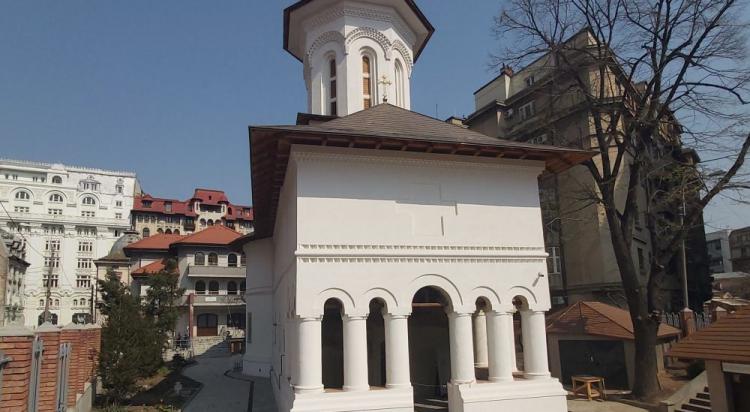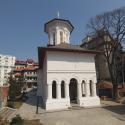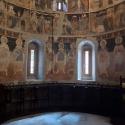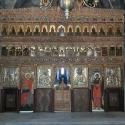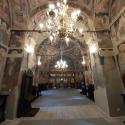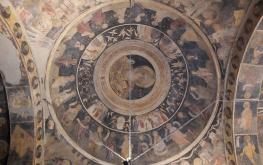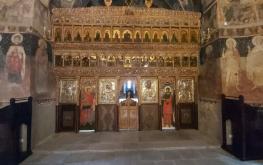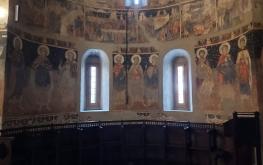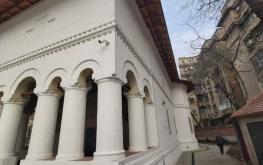The architecture historical monument, the Church Scaune with the Patronages Dormition of the Mother of God and the Nativity of the Mother of God is located in the center of the Capital City, behind Colțea Hospital, at the crossroads of Scaune, Slănic and Dimitrie Bolintineanu streets. A tributary of Dâmbovița - a brook - the Bucureștioara backwater, on the bank of which the 'Scaune' neighborhood was located, passed by. Its name comes from the old butchers' guild that used to line up their butcher blocks here ('Scaune' in Romanian), that is, the wooden logs on which they cut the meat. The soap makers were also present, making soap from the tallow left over from the animals slaughtered in the cattle market, located on the outskirts of the city.
The earliest references to the place of worship are from 1669 and then from 1675. In a charter of ruler Șerban Cantacuzino in 1681, the church is referred to as the Church of Soap Makers.
In 1701, the ruler Constantin Brâncoveanu called it the 'Church of Crețuleștilor', and in the Bucharest plan drawn up by the Russian officers, in 1770, the church was named the 'Church of Butchers'.
The construction of the current church was started on the site of the old wooden one by the Bulgarian merchant Atanasie from Tarnovo, and the work was completed by his nephew Stavro on September 8, 1705 (7214). The Pisania (inscription) records this:
'This church, dedicated to the Dormition of the Mother of God, built with the diligence of the late Atanasie of Târnovo, feeling that his end is near - left his life savings to his nephew Stavro, to make this building, with what is seen, for his always remembrance and of all his people, forever, this very day of September, 8 days, 7214.'
In 1843, at the expense of Postelnic (chamberlain) Ioan Costacopulo, the church was painted 'fresh start', it was plastered on the outside and the church porch arches were closed with masonry.
The following repairs appear in documents as being made in 1878.
For about 30 years, between 1910 and 1939, the church was abandoned.
Between 1939 and 1944, repairs to the church were carried out both inside and outside. The most important achievements of the mentioned period are the introduction of electric light inside the monument, the restoration of the interior floor with Buzău stone and the paving of the courtyard in front of the church with stone. Excavation work was also carried out to clear the land around the church, as the church was buried below the surrounding streets by about one metre.
Furthermore, during this period, the painting was restored by painter Gheorghe Popescu, the iconostasis and the baldachin of the altar. The church was restored to the divine cult on August 15, 1944, the day of the celebration of first patron saint of the church, and on September 8, it is re-consecrated, receiving the second patron saint.
Starting 1950, architect Ștefan Balș drafted a new restoration project that resulted in the current appearance of the church.
In 1982, new repair and consolidation works were carried out consisting mainly of the installation of concrete steel tie rods at the level of the arches and vaults, the repair of the roof and the plastering.
RESTORATION OF THE CHURCH
On August 17, 2017, with the blessing of the Patriarch of the Romanian Orthodox Church DANIEL, the Scaune Parish, represented by the Parish Priest Dantis Jenica, signed with the Ministry of Regional Development and Tourism (as Managing Authority), through the Bucharest-Ilfov Regional Development Agency (Intermediate Body), the financing contract no. 354, SMIS code 118744.
The non-refundable financial assistance, totalling RON 9,045,325.40 (of which 128,282.40 - own contribution), was obtained through the Regional Operational Programme 2014-2020, Priority Axis 5 - Sustainable development and promotion of tourism, Major Field of Intervention 5.1 – Restoration and sustainable valorization of cultural heritage and the establishment and modernisation of related infrastructure.
Works were carried out to consolidate the church, completely replacing the timber roof truss and the roof covering, the interior painting, iconostasis and liturgical furniture were restored.


